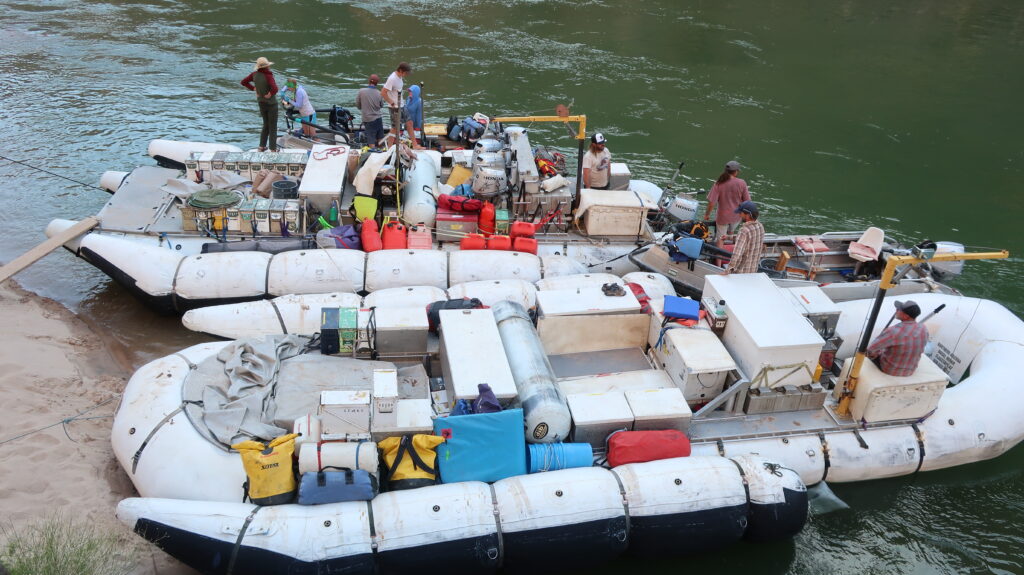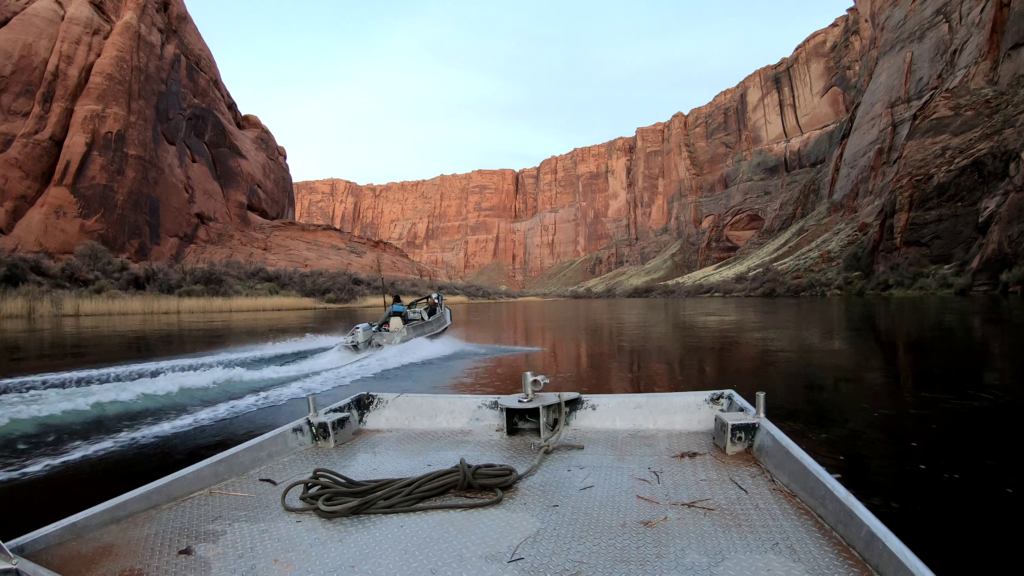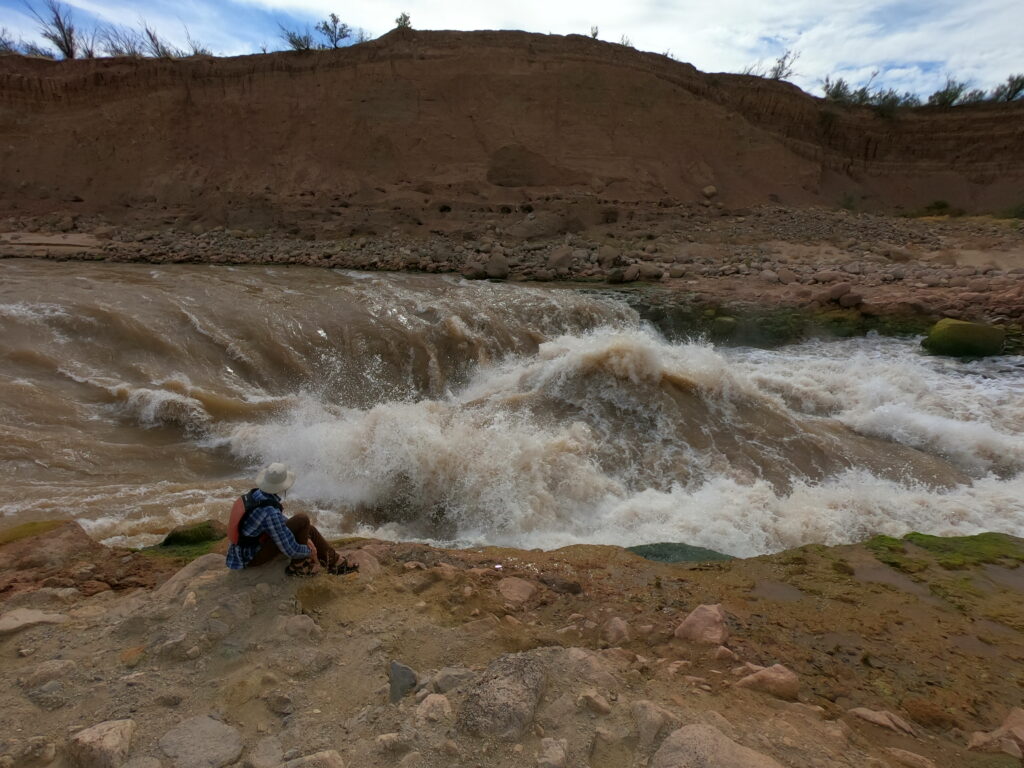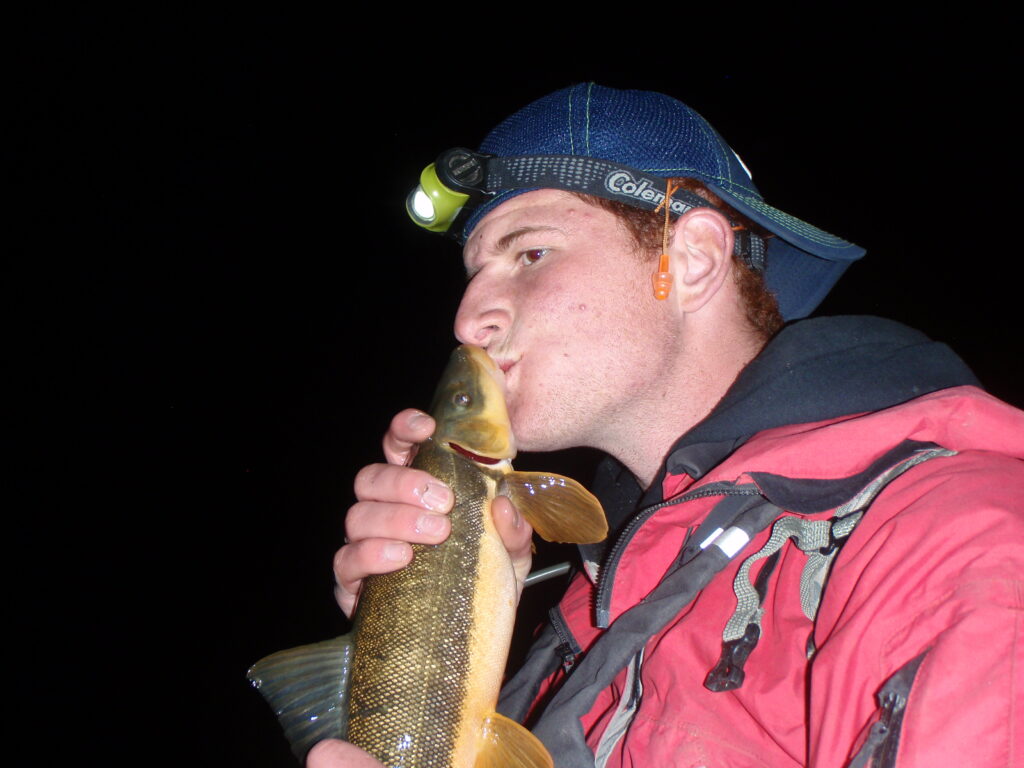Arizona Game and Fish Department
Most of my current research and day to day activities with Arizona Game and Fish Department revolve around fishes of the Colorado River between Glen Canyon Dam and Lake Mead. We have three main field projects and a few laboratory projects.
Colorado River Long Term monitoring
Our goal is to monitor all of the fish in the Colorado River, Grand Canyon. This includes native fishes as well as non-native fishes. We use a variety of gear: electrofishing, hoop nets, and angling, to target specific species. This work is funded through the Glen Canyon Dam Adaptive Management Program and conducted in collaboration with USGS-Grand Canyon Research and Monitoring Center and has been occurring since 2001.

Lees Ferry rainbow trout fishery
We monitor the fishery at Lees Ferry, which is the 15 mile reach downstream of Glen Canyon Dam. We conduct three electrofishing trips per year (spring, summer, autumn), conduct angler surveys six times a month, and have a citizen science project where guides and interested anglers record the length of all fish captured.
I am working with a team (Team Physh) of Northern Arizona University undergraduate students in the Computer Sciences Program – as part of their capstone project they are developing a mobile phone application for AZGFD. I called it Fish Identification Search History “FISH” 🙂 It is an application that will interface with passive integrated transponders (PIT) tag scanner to identify fish that have been tagged and provide information on the history of the tagged fish that an angler captured (when it was last captured, what size it was, etc.). Anglers will also have the option of entering new information on the tagged fish they captured. This is a means to get more information on the fishery at Lees Ferry, and improve angler engagement.

Pearce Ferry Rapid
We are investigating whether Pearce Ferry is a hindrance to fish movement, does it prevent non-natives from Lake Mead from moving upstream, or native fish, such as the endangered razorback sucker. The razorback sucker used to move between the Colorado River and Lake Mead, but may not anymore. This work is in conjunction with BIOWEST supported by The Bureau of Reclamation (BOR), and our (AZGFD) work was initially funded by the US Fish and Wildlife Service, and National Park Service, with logistical support by the USGS – Grand Canyon Monitoring and Research Center.
Our funding from the NPS and USFWS ended in 2023, fortunately we were able to secure funding from the BOR and our work at Pearce Ferry Rapid will continue for the next five years (2024-2029).
Check out a talk I gave to the Collaborative Conservation and Adaption Strategy Toolbox (CCAST) folks on 17 March 2021. It was recorded and uploaded to Youtube – my talk begins at 28:45.

Most of my current research and day to day activities with Arizona Game and Fish Department revolve around fishes of the Colorado River between Glen Canyon Dam and Lake Mead. We have three main field projects and a few laboratory projects.
Colorado River Long Term monitoring
Our goal is to monitor all of the fish in the Colorado River, Grand Canyon. This includes native fishes as well as non-native fishes. We use a variety of gear: electrofishing, hoop nets, and angling, to target specific species. This work is funded through the Glen Canyon Dam Adaptive Management Program and conducted in collaboration with USGS-Grand Canyon Research and Monitoring Center and has been occurring since 2001.

Lees Ferry rainbow trout fishery
We monitor the fishery at Lees Ferry, which is the 15 mile reach downstream of Glen Canyon Dam. We conduct three electrofishing trips per year (spring, summer, autumn), conduct angler surveys six times a month, and have a citizen science project where guides and interested anglers record the length of all fish captured.
I worked with Team Physh of Northern Arizona University undergraduate students in the Computer Sciences Program – as part of their capstone project to develop a mobile phone application for AZGFD. I called it Fish Identification Search History “FISH” 🙂 It is an application that will interface with passive integrated transponders (PIT) tag scanner to identify fish that have been tagged and provide information on the history of the tagged fish that an angler captured (when it was last captured, what size it was, etc.). Anglers will also have the option of entering new information on the tagged fish they captured. This is a means to get more information on the fishery at Lees Ferry, and improve angler engagement. Unfortunately, two years later I am still waiting for AZGFD to set up the application.

Pearce Ferry Rapid
We are investigating whether Pearce Ferry is a hindrance to fish movement, does it prevent non-natives from Lake Mead from moving upstream, or native fish, such as the endangered razorback sucker. The razorback sucker used to move between the Colorado River and Lake Mead, but may not anymore. This work is in conjunction with BIOWEST supported by The Bureau of Reclamation (BOR), and our (AZGFD) work was initially funded by the US Fish and Wildlife Service, and National Park Service, with logistical support by the USGS – Grand Canyon Monitoring and Research Center.
Our funding from the NPS and USFWS ended in 2023, fortunately we were able to secure funding from the BOR and our work at Pearce Ferry Rapid will continue for the next five years (2024-2029).
Check out a talk I gave to the Collaborative Conservation and Adaption Strategy Toolbox (CCAST) folks on 17 March 2021. It was recorded and uploaded to Youtube – my talk begins at 28:45.

Paria river
The Paria River is a small tributary to the Colorado River at Lees Ferry. We recently (spring 2025) started a pilot project tracking fish movement associated with spawning in the Paria River. We placed two PIT tag antennas upstream of the Lonely Dell Ranch.
Hybridization between Flannelmouth Suckers and Razorback Suckers
Check out these two videos produced by AZGFD about our work with hybrids
- 1) Pilar Wolters, fish biologist, discusses Razorback & Flannelmouth Sucker Hybridization
- 2) Pilar Wolters, fish biologist, discusses Razorback & Flannelmouth Sucker Hybridization
